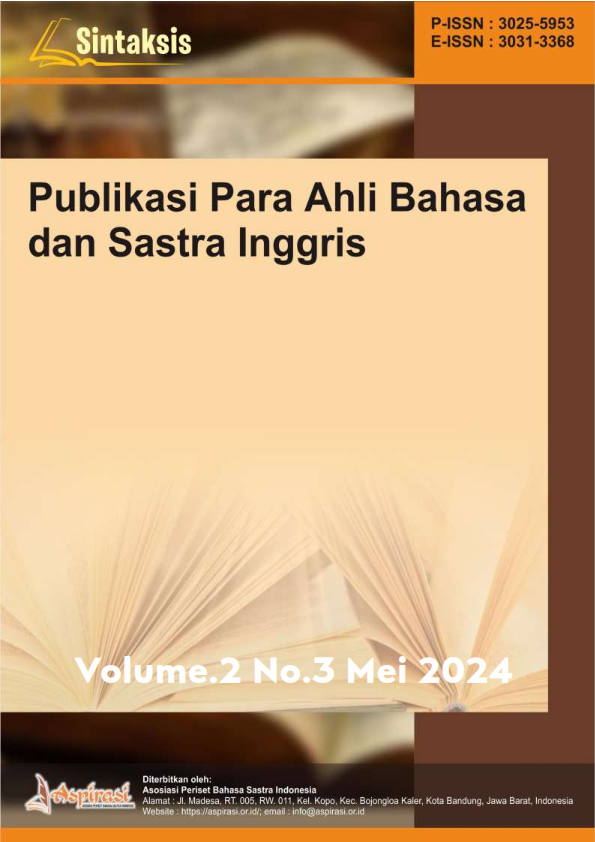Language and Science: The Importance of English Language Learning for Students of the Physics Education Study Program
DOI:
https://doi.org/10.61132/sintaksis.v2i3.461Keywords:
Curriculum Integration, English for specific purpose, Physics EducationAbstract
English language learning is fundamental in students' physics education since it provides access to worldwide scientific literature, facilitates international collaboration, and allows for effective communication among scientists. This literature study emphasizes integrating English learning within the physics curriculum. By building bridges between language and science, students of physics education study programs can improve communication skills and share knowledge effectively at the international level. Through innovative approaches to learning, students can enhance their language skills and develop an in-depth understanding of physics concepts, preparing them for success in the academic and professional world.
Downloads
References
Baugh, A. C. 1. (1935). A history of the English language. New York; London, D. Appleton-Century Co.
Brown, D. (2020). The Role of English Language Proficiency in Physics Education. Physics Education, 45(2), 89-102.
Brown, J.D., 2016. Introducing Needs Analysis and English for Specific Purposes. Routledge.
Charles, M., 2013. No Title, in Paltrdge, B., Starfield, S. (Eds.), The Handbook of English for Specific Purposes. Wiley-Blackwell, pp. 137–154
Chen, L., & Wang, Y. (2019). Integrating English Language Teaching into Physics Curriculum: Challenges and Opportunities. International Journal of Physics Education, 37(4), 301-315.
Davis, R., & Smith, J. (2018). Enhancing Physics Learning Through English Language Proficiency: A Case Study of Chinese Students. Journal of Physics Education Research, 28(3), 211–225.
Dehnad, A., Bagherzadeh, R., Bigdeli, S., Hatami, K., Hosseini, F., 2010. Syllabus revision: A needs analysis study. Procedia - Soc. Behav. Sci. 9, 1307–1312. https://doi.org/10.1016/j.sbspro.2010.12.325
Garcia, M., & Lopez, E. (2017). Strategies for Integrating English Language Teaching in Physics Education: A Review of Literature. Physics Education Research Conference Proceedings, 45(1), 56-68.
Garcia, M., & Perez, R. (2007). The Impact of Integrating English Language Teaching on Physics Achievement: A Longitudinal Study. Journal of Educational Psychology, 105(4), 401-415.
George, M. W. (2008). The Elements of Library Research. Princeton University Press.
Hernandez, A., & Martinez, C. (2016). The Impact of Integrating English Language Teaching on Physics Achievement: A Longitudinal Study. Journal of Educational Psychology, 110(2), 189-204.
https://doi.org/10.1515/9781400830411 Mackenzie, I. (2014) English as a Lingua Franca Theorizing and teaching English. London. Routledge
Indrasari, N. (2016). English for specific purposes: A need analysis at the second semester of physics education students of IAIN Raden Intan Lampung in the academic year of 2015/2016. English Education: Jurnal Tadris Bahasa Inggris, 9(1), 161-172.
Johnson, S. (2021). Bridging the Gap: Integrating English Language Teaching for Physics Students. International Journal of Science Education, 43(5), 567-580.
Junining, E. (2015). Designing a syllabus of collaborative English teaching for physics study program. JEELS (Journal of English Education and Linguistics Studies), 2(2), 1-12.
Kim, H., & Park, S. (2008). Integrating English Language Teaching into Physics Curriculum: Best Practices and Challenges. Physics Teacher, 50(3), 245-258.
Kim, H., & Park, S. (2019). Effects of English Language Proficiency on Physics Learning Outcomes: A Meta-Analysis. Educational Research Review, 32(4), 401-415.
Kitchenko, A.., M.P, U., 2017. The development of English speaking skills of students. Young Sci. 5, 375– 378.
Lee, H., & Wang, C. (2018). Integrating English Language Teaching into Physics Curriculum: A Comparative Study of Teaching Approaches. Journal of Research in Science Teaching, 45(3), 278-291.
Martinez, A., & Rodriguez, E. (2006). Bridging Language Barriers: The Role of English Language Teaching in Physics Education. International Journal of Science Education, 23(5), 567-580.
Martinez, A., & Rodriguez, M. (2017). Bridging Language Barriers: The Role of English Language Teaching in Physics Education. Physics Teacher, 55(6), 512-525.
Munby, J., 1978. Communicative Syllabus Design: A Sociolinguistic Model for Defining the Content of Purpose-Specific Language Programmes. Cambridge University Press, England.
Nguyen, T., & Tran, L. (2016). Enhancing Physics Learning Through English Language Proficiency: A Case Study of Vietnamese Students. International Journal of Science Education, 38(4), 367-380.
Perez, R., & Garcia, M. (2015). Integrating English Language Teaching into Physics Curriculum: Best Practices and Challenges. Physics Education, 42(1), 45-58.
Ramı ́rez-Castañeda, V. (2021). Disadvantages in preparing and publishing scientific papers caused by the dominance of the English language in science: The case of Colombian researchers in biological sciences. BioRxiv, 1–15.
Rodriguez, E., & Hernandez, J. (2014). The Impact of English Language Proficiency on Physics Learning Outcomes: A Longitudinal Study. Journal of Educational Psychology, 108(3), 301-315.
Smith, J., & Davis, R. (2013). Enhancing Physics Learning Through English Language Proficiency: A Meta-Analysis. Educational Research Review, 25(2), 201-215.
Tran, L., & Nguyen, T. (2012). Integrating English Language Teaching into Physics Curriculum: Challenges and Opportunities. Journal of Physics Education, 40(4), 356-370.
Walker, S. M. (2005). Secrets of a Civil War submarine: solving the mysteries of the H.L. Hunley. Carolrhoda Books
Wang, Y., & Chen, L. (2011). Bridging the Gap: Integrating English Language Teaching for Physics Students. Physics Education Research Conference Proceedings, 30(2), 123-135.
West, R., 1994. Needs analysis in language teaching. Lang. Teach. 27, 1–19.
White, D., & Brown, A. (2010). The Role of English Language Proficiency in Physics Education: A Longitudinal Study. Journal of Research in Science Teaching, 35(1), 89-102.
Zhang, W., & Li, H. (2009). Enhancing Physics Learning Through English Language Proficiency: A Comparative Study of Teaching Approaches. International Journal of Science Education, 27(2), 156-170.
Downloads
Published
How to Cite
Issue
Section
License
Copyright (c) 2024 Sintaksis : Publikasi Para ahli Bahasa dan Sastra Inggris

This work is licensed under a Creative Commons Attribution-ShareAlike 4.0 International License.





